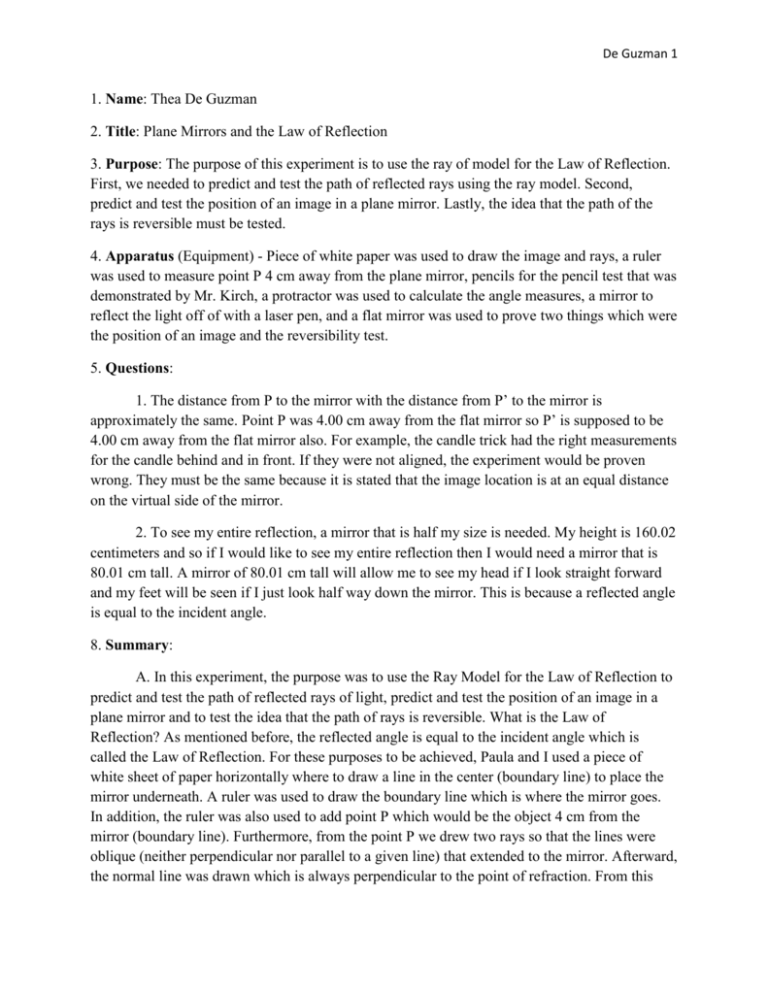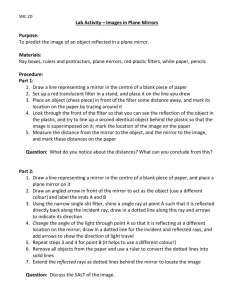Ray Lab Report
advertisement

De Guzman 1 1. Name: Thea De Guzman 2. Title: Plane Mirrors and the Law of Reflection 3. Purpose: The purpose of this experiment is to use the ray of model for the Law of Reflection. First, we needed to predict and test the path of reflected rays using the ray model. Second, predict and test the position of an image in a plane mirror. Lastly, the idea that the path of the rays is reversible must be tested. 4. Apparatus (Equipment) - Piece of white paper was used to draw the image and rays, a ruler was used to measure point P 4 cm away from the plane mirror, pencils for the pencil test that was demonstrated by Mr. Kirch, a protractor was used to calculate the angle measures, a mirror to reflect the light off of with a laser pen, and a flat mirror was used to prove two things which were the position of an image and the reversibility test. 5. Questions: 1. The distance from P to the mirror with the distance from P’ to the mirror is approximately the same. Point P was 4.00 cm away from the flat mirror so P’ is supposed to be 4.00 cm away from the flat mirror also. For example, the candle trick had the right measurements for the candle behind and in front. If they were not aligned, the experiment would be proven wrong. They must be the same because it is stated that the image location is at an equal distance on the virtual side of the mirror. 2. To see my entire reflection, a mirror that is half my size is needed. My height is 160.02 centimeters and so if I would like to see my entire reflection then I would need a mirror that is 80.01 cm tall. A mirror of 80.01 cm tall will allow me to see my head if I look straight forward and my feet will be seen if I just look half way down the mirror. This is because a reflected angle is equal to the incident angle. 8. Summary: A. In this experiment, the purpose was to use the Ray Model for the Law of Reflection to predict and test the path of reflected rays of light, predict and test the position of an image in a plane mirror and to test the idea that the path of rays is reversible. What is the Law of Reflection? As mentioned before, the reflected angle is equal to the incident angle which is called the Law of Reflection. For these purposes to be achieved, Paula and I used a piece of white sheet of paper horizontally where to draw a line in the center (boundary line) to place the mirror underneath. A ruler was used to draw the boundary line which is where the mirror goes. In addition, the ruler was also used to add point P which would be the object 4 cm from the mirror (boundary line). Furthermore, from the point P we drew two rays so that the lines were oblique (neither perpendicular nor parallel to a given line) that extended to the mirror. Afterward, the normal line was drawn which is always perpendicular to the point of refraction. From this De Guzman 2 data, we are able to calculate the angle. The angles on the left side were 31 degrees and the right angles were 34 degrees. From this data, we predicted that the path of each reflected ray would bounce of the mirror reflecting it which is shown in the data. The purpose was to predict and test the path of reflected rays of light which was achieved when the laser pen was tested on the ray of light through point P. Since the light reflected from the mirror, you can see that the light itself following the path of each of the incident ray that was drawn. In addition to the lab, an Image Determination was performed by predicting where the image would appear using the Ray Model of Light. First, we had to predict where the 2 sight line (the brain tells us that the sight lines are where the light is coming from) would intersect on the “other” side of the mirror. In order to do that we had the remove the mirror and extend the reflected segments until they intersected. This was labeled as the intersection point P’. Point P’ is the image. The reflected light seems to be coming from where the image is seen so it means that the image is virtual. To test our prediction, Mr. Kirch was called over to demonstrate the famous pencil trick. In the pencil trick demonstration, a pencil was place on P’ and another on point P. We were able to see the optical illusion. This was very significant because it showed that the object P was reflected towards the mirror lines with the half of the other pencil object P’ behind the mirror. The purpose was achieved because the P’ proves that it is where the image is seen when the objected P’ has been reflected. We then measured the image from the mirror and stated that it was 3.60 cm away when it was supposed to be 4.00 cm. The last purpose was reversibility which means the ability of the path of a ray to go backwards or forwards. To test the idea of reversibility, we first predicted that the laser would reflect of the mirror following the predicted pathway. This purpose was achieved because we tested the other ray that was not tested before and the laser did pass through the predicted path meaning our prediction was correct. B. Sources of Error are always present in lab and there are three types of error which are human error, systemic error, and assumption error. 1. Human Error: This may have occurred when my measurements was less than precise with the ruler used and might of given us the incorrect length of the distance of point P to the mirror. 2. Systemic Error: This may have occurred due to the mirror. A mirror can be a source of error because it may not be perfect. A mirror might have been bent and can cause an error stating that the ray should reflect the other way when it is not supposed to. 3. Assumption Error: This may have occurred if the protractor is incorrect with its measurements. This will give us the angles measurements incorrectly, the degree measurements might be of been wrong or the center was probably in wrong placement on the protractor.





